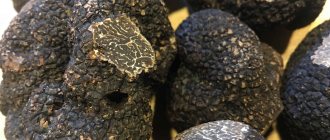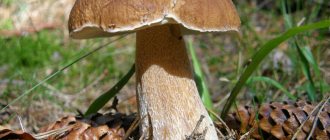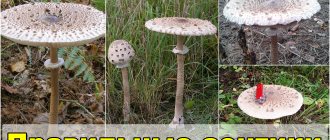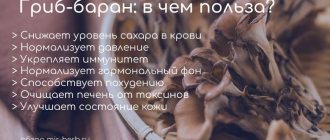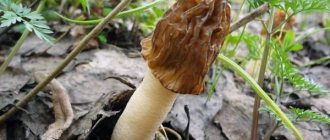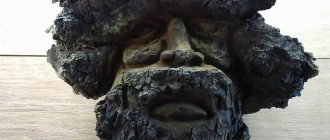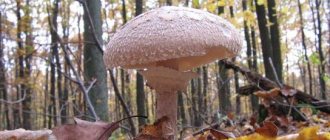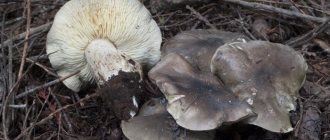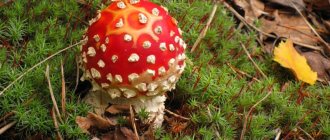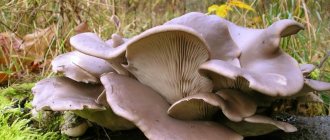In the middle and end of May, the first species of collibia appear. These include primarily chestnut or buttercollibia. These cute little mushrooms attract with their spectacular appearance, although they are small in size. Although they are edible, they are not collected due to their small size and the lowest, fourth category in terms of nutritional properties.
Collibias grow primarily on tree roots and on the forest floor. October collibias appear among fallen leaves and are barely noticeable.
Is the forest-loving Kollibia edible or not?
Wood-loving collibia is conditionally edible; only the tops are eaten, but they are rarely used in cooking, since preparations require a large amount of product, and the taste of spring honey fungus will not please everyone.
If wood-loving colibia is not processed correctly, a person who does not suffer from a digestive disorder may experience pain in the stomach or intestines. The aroma of a mushroom dish is also repulsive; to many it resembles the smell of mold or rot. However, adherents of a healthy lifestyle collect and eat wood-loving collibia, because scientists have proven that it contains a large number of active elements that are beneficial to health. They increase the body's immunity and resistance to infections, promote heart function and strengthen blood vessels, and are a natural antioxidant, immunostimulant and antiviral agent. The wood-loving collibium is high in protein, carbohydrates and fiber, as well as vitamins (B1 and C), zinc, copper and minerals.
Distribution and collection
You can meet wood-loving collibia in forests of various types, both deciduous and coniferous, and mixed. It can grow on dead wood, old stumps, and other rotting plant debris. Maximum yield is observed in June and July. Occurs quite often, in numerous groups.
The money is ordinary.
The oak grove collibia grows from mid-May to the end of autumn.
Description of wrapped Kollibia
Collibia wrapped or money-shod is a fragile, miniature specimen that grows in temperate regions. Since the mushroom is inedible, it is necessary to know a detailed description in order not to get an upset stomach.
Description of the cap
The cap is small, up to 60 mm in diameter. In young specimens it is bell-shaped, and as it grows it straightens, maintaining a small mound in the center. The surface is covered with thin matte skin with pronounced whitish spots. In dry weather, the mushroom is colored light coffee or cream. When it rains, the color changes to dark brown or ocher. The pulp is dense, brown-lemon.
The spore layer is covered with thin long plates, which partially adhere to the stalk. When young they are canary in color, changing to red or light brown as they mature.
Reproduction occurs by transparent elongated spores, which are found in a pale yellow spore powder.
Description of the leg
An elongated leg, widening towards the bottom, up to 70 mm long. The skin is smooth, fibrous, gray-canary in color, covered with a lemon felt coating. The lower part is whitish, covered with mycelium. The ring at the base is missing.
Butyracea, f. asema form (Collybia butyracea, f. asema)
HABITAT: mixed and coniferous forests, grow in groups.
SEASON: May - September.
The cap has a diameter of 2-5 cm, at first convex with a drooping edge, later convex-spread. A distinctive feature of the species is a cap with three zones: the central, darkest - brownish, the second concentric - cream, or cream-pink, the third concentric zone at the edges - brownish.
The leg is 3-7 cm tall, 3-8 mm thick, cylindrical, at first white, later light cream and gray-cream. Near the base of the leg, separate zones of a reddish-brown color appear over time.
The pulp is dense, fibrous, whitish, without much odor, the spore powder is light cream.
Medium-frequency plates, initially white, later cream-colored, notched.
Variability: The color of the central zone of the cap varies from brownish to brown, and the concentric zones range from cream to yellow-brown.
Similar species. This species is similar to Collybia dryophila, which also has concentric zones of cap color, but their central zone is reddish-brown and the next zone is yellowish-cream.
Inedible.
Description of wood-loving collibia
In young mushrooms, the shape of the cap resembles a sphere, but over time it becomes prostrate, flat with almost transparent edges. The diameter of the cap is 2-6 centimeters. Young mushrooms look like apples lying on fallen leaves.
The color of the cap can be reddish and reddish with an ocher tint. The center has a darker color, and towards the edges it gradually becomes lighter. Old mushrooms take on a pale ocher color, while young colibia are translucent. With high humidity, the shade of the cap becomes more pronounced, and during drought, the colibia becomes inconspicuous.
Through the transparent edges of the wood-loving collibium, plates are visible, weakly attached to the base. With age, mushrooms seem to become covered with rust; red spots and stains form on the inside. The translucent edges are torn.
The stem of the mushroom is thin and slightly curved. The legs are empty inside. The length of the legs can vary from 2 to 6 centimeters. The structure of the leg is fibrocartilaginous. The shade of the stem matches the cap. The stem is slightly thickened at the bottom, while the mushroom looks proportional.
The pulp is formed by frequent thin plates of brown or lemon color, sometimes the pulp can be white. The color of the pulp depends on the age of the mushroom and weather conditions. The pulp strongly absorbs moisture, it is thin and tender. The spores are ellipsoidal in shape.
Edibility of spring honey fungus
These are edible mushrooms that can be used in cooking, but their taste is considered to be poor. If a person suffers from a digestive system disorder, then after eating colibia, he may experience intestinal and stomach pain.
Wood-loving collibia is not popular among culinary specialists because it has little softness. In addition, it does not have a rich taste. There may be virtually no smell, or there may be a smell of rot or mold.
Places of distribution of wood-loving collibia
Autumn honey mushrooms grow in deciduous and coniferous forests, most often they are found in the European part of Russia. Collibias do not grow in gardens and lawns, which is why they are called wood-loving species.
The first mushrooms appear in May and bear fruit until late autumn. They can be found in fallen leaves and on rotting stumps, from which they obtain moisture and nutrients. But they can also settle on the trunks of living trees. Sometimes wood-loving collibias parasitize other types of fungi.
Similar species
Newcomers among mushroom pickers may confuse collibias with honey mushrooms. But honey mushrooms have a distinct mushroom aroma and taste. The caps of meadow mushrooms are dense, oval in shape, and in old age they become prostrate. There is a tubercle in the center of the cap.
Wood-loving colibia can be confused with other types of colibia, and some of them can be poisonous and pose a danger to human life. Even experienced mushroom pickers are unable to detect the difference, since the differences are noticeable only under a microscope. The only good news is that other types of colibia are found very rarely.
Related species
A related species of wood-loving collibia is oil-loving collibia, which is also a conditionally edible mushroom. The diameter of the cap is 2-12 centimeters.
The pulp is watery, white, without any particular smell or taste. The spores are ellipsoidal in shape. At a young age, the cap is convex, sometimes there may be a tubercle in the center.
The surface is smooth, but becomes oily in wet weather. The color of the cap is brown or red-brown, becoming light brown over time.
The length of the stalk of buttercollibia is 2-12 centimeters, with a width of 0.4-1 centimeter. The leg is relatively flat, hard, smooth and most often hollow. Spore powder is pinkish, yellowish or cream in color.
Edible mushrooms, berries, herbs
Collybia fusipes
The spindlefoot collibia can be found from the second ten days of July to the third ten days of September in deciduous forests (most often where there is oak or beech). Prefers to grow near oak (beech) stumps, tree roots, along fallen trunks, around stumps. It grows in fairly large groups, united in bunches. It is most widespread in the southern regions of our country.
The cap, 3-8 cm in diameter, is at first bell-shaped, later convex-lumpy with a smooth surface. The color is brownish-brownish or reddish-reddish-brownish with a darker center. In adult individuals, the surface of the cap is most often uneven with cracked edges, and the color becomes lighter. Red-brown spots may also appear on the surface.
The plates are sparse, mid-frequency, poorly adherent, grayish-white in color with red-brown spots.
The leg has a spindle-shaped shape, swollen just below the middle. 6-9 cm in length, 0.5-1.8 cm in diameter. The structure is longitudinally fibrous, wrinkled and furrowed. The swollen part is almost hollow, light at the top, red-brown at the bottom, and brown at the very base. Very often the leg is twisted or longitudinally twisted.
The pulp is white, thin-fleshed, elastic, somewhat harsh in the stem, with a subtle odor.
It is considered a mildly poisonous mushroom. However, in some reference books it is equated to edible or conditionally edible. Thus, the French writer-mycologist Gerard Houdou in his encyclopedia “Mushrooms” advises collecting the caps of young spindle-footed collibias and using them fresh or pickled.
Photos of Collybia fusipes
A video about the spindlefoot collibia, which allows you to better understand the structure of the fruiting body and imagine how the mushroom grows in the forest.
https://youtube.com/watch?v=wX23ZqglddE
What is the value of the “money” mushroom Kollibia chestnut?
Collibia oleracea is a mushroom of the non-rotting family. It grows in temperate latitudes in Europe and North America. Currently, about 70 of its varieties are known; in Russia there are more than 20 species.
Description
Lat. Rhodocollybia butyracea, Collybia butyracea. Other names are Rhodocollibia oily, Kollibia oily, Kollibia chestnut, Money oil.
This is a genus of capped, late-ripening, conditionally edible, collibioid mushrooms of the Ryadovkov family, which are often called “money” for their external resemblance to small coins.
hat
The young mushroom has a hemispherical cap. Over time, it becomes more convex, and later takes on a prostrate, slightly depressed appearance with upward-curved edges. Its diameter is 2–12 centimeters. Some specimens have a small tubercle in the center.
The cap of the Collibia oilseed is hygrophanous, that is, it is capable of changing its appearance depending not only on age, but also on the level of humidity in the growing area. In rainy weather, its surface becomes oily.
The color of the cap can be light brown, reddish, burgundy, chestnut, or brown. The edges are painted in lighter colors.
Hymenophore
The lower part of the cap, or hymenophore, consists of a large number of frequently located plates. They are located freely or can be tightly attached to the leg. Between the large plates there are shortened intermediate ones.
A characteristic feature of collibia is the white color of the hymenophore. During the ripening process, it acquires a pink tint, and with age the plates become darker.
The spores are smooth and have a slightly elongated elliptical shape. Their powder is white, pale yellow or pinkish in color.
Pulp
Collibia is a thin-fleshed mushroom. The pulp is watery and white or light brown in color. Under the skin it is a rich brown color.
Leg
The leg is smooth, cartilaginous, rigid, hollow inside. Its length ranges from 2 to 10 cm, its girth can reach 1 cm. In the upper part, under the cap, it is slightly flattened, and in the lower part it has a slight thickening, covered with a white felt coating.
Time and place of fruiting of oil money
The mushroom is quite rare. At the same time, it is well camouflaged near the bases of trees and is not always noticeable to mushroom pickers.
Rhodocollybia butyracea is a saprotroph that grows in coniferous and deciduous forests on dried wood, grass, mosses or leaf litter. Most often it can be found in a pine forest.
It grows from the beginning of summer until the first snow, when there are no other relatives. When harvesting, the fruiting body is cut off at the root, and this place is covered with earth or leaves.
False doubles
The main difference between the money and related species, including inedible ones, is the oily cap. The following varieties may be of interest to lovers of “silent hunting”:
- Collibia spotted. It belongs to the conditionally edible mushrooms and close relatives of the butter mushroom. It has a conical or hemispherical cap with the edges turned down. Its surface is white with brown-rusty spots, which serve as a distinctive feature. The pulp is elastic and very dense. The leg is slightly curved, painted white with small brown spots on the surface. It requires moist and acidic soil to grow. Found in very large families.
What is the difference between different types of colibia can be seen in the photo
Taste qualities of Collibia oily
Buttercollibia has a sawdust taste, so it is rarely eaten, although it is classified as a conditionally edible mushroom. To get rid of the unpleasant taste, it is first boiled for 10–15 minutes. Only the caps are used for cooking.
Cooking recipes
After collection, collibia should be properly processed.
- To do this, pour it into a large container and fill it with cold, lightly salted water for 10 minutes. This procedure will help you quickly get rid of dirt, soil, stuck leaves and insects.
- Then the mushrooms are washed and the caps are separated from the stems, since money butter stems are hard and are not used for cooking.
- Clean fruiting bodies are placed in a large saucepan, filled with cold water and brought to a boil over high heat.
- Reducing the flame, cook for another 15 minutes, then drain and rinse with running water.
Cooked mushroom preparation can be used with onions, carrots, garlic, pepper and sour cream. Collibium goes well with stewed potatoes, chicken and meat. It can also be pickled and salted.
Interesting Facts
- Rhodocollibia oilseed grows in large families in which the mushrooms are arranged in rows or rings.
- Tolerates the first autumn frosts well. Sometimes the collection continues after the first snow falls.
- It is often called “money” for its external resemblance to small coins scattered in the grass.
- All types of mushrooms are very similar to each other. It has several poisonous counterparts, so you need to be very careful when collecting.
Information sources
- Arora D. Mushrooms Demystified: a Comprehensive Guide to the Fleshy Fungi. - 2. - Ten Speed Press, 1986
- Gribi Khmelnytchini. Chief assistant. Govorun V. D., Tymoshchuk O. O. - Khmelnitsky: Polygraphist-1, 2014
Doubles and their differences
Collibia oilum, like any representative of the mushroom kingdom, has doubles. These include:
- Tuberous is a small poisonous species. The edges of the hemispherical, red-brown cap are fragile and bent inward. They grow throughout the fall in small families. The variety is often confused with saffron milk caps and russula, so in order not to make mistakes when collecting, you need to know the varietal characteristics.
- Spotted is a conditionally edible specimen. The bell-shaped cap is whitish in color at a young age; with age, it straightens and becomes covered with rusty spots. The pulp is dense and fleshy. The variety grows from August to September in large groups in acidic, moist soil.
Satanic mushroom (Boletus satanas)
A tubular mushroom belonging to the boletus genus. In our country it grows in the Caucasus, in the southern regions of the European part and in the south of the Primorsky Territory, where it settles in forests. Forms a symbiosis with trees such as linden, oak, beech, chestnut and others. It is similar to the edible oak mushroom; it is easy for an inexperienced mushroom picker to make a mistake.
Satanic mushroom
A large mushroom with a cushion-shaped cap up to 20 cm in diameter, light gray or ocher-white in color. A sponge consisting of tubes with red stomata is visible on the underside. The leg is 10 cm long, thick (up to 6 cm in diameter), yellowish, and has a red mesh at the bottom. Old mushrooms emit a very unpleasant odor.
In some habitats it is considered conditionally poisonous, and with appropriate processing it is eaten. However, there is no reliable data on the safety of this mushroom, so you should not conduct experiments on yourself and your loved ones.
When picking mushrooms, you need to be careful and careful
When picking mushrooms, you need to be careful and careful. Never take a mushroom if you doubt its safety. The following video describes the ten most poisonous mushrooms found in the CIS countries.
https://ogorod-bez-hlopot.ru/opisanie-korichnevyx-gribov.html
https://vk.com/topic-48875560_27562447
https://7dach.ru/LenaMedvednikova/top-10-yadovityh-gribov-kotorye-tochno-ne-stoit-klast-v-korzinu-148897.html
Mushroom Kollibia: forest-loving, oil-loving and others
The collibium mushroom belongs to the Tricholomaceae family. It has several varieties, among which the most famous are wood-loving, broad-plated, butter and spindle-footed collibia.
Description of the Kollibia mushroom and its varieties
general characteristics
All representatives of the genus Kollibia have similar characteristics:
- The mushroom cap is thin-fleshy, in rare cases has developed flesh, small in size, does not exceed 2 cm in diameter, convex in shape at the initial stage of growth, subsequently flat-prostrate, in adult specimens a pit appears in the central part, in young mushrooms it has rolled edges, color pale in shades of white, brown and yellow,
- the mushroom hymenophore is formed by frequent plates, the bases attached to the mushroom stalk or free, the color of the hymenophore plates is pale cream or light brown,
- The mushroom stalk is thin in shape, covered with a powdery coating, the lower part of the stalk is hairy, the shape of the stalk is often even, in some cases swollen.
Some varieties of collibia form sclerotia.
Geography of distribution
The genus of collibia is widespread in temperate latitudes in European and North American territories. In total there are about 70 varieties, about 20 species are found in Russia.
Collibias are sapostrophes, growing in coniferous and deciduous forests on rotten fruiting bodies of other types of mushrooms, on forest litter and dried wood, preferring grass and mosses. In rare cases, they settle on living trees.
Spindlefoot
The spindlefoot collibia grows on the stumps and roots of old deciduous trees, preferring oak and beech. The cap is 4.0-8.0 cm in diameter, with a blunt tubercle. The leg is spindle-shaped, 4-8 cm long, 0.5-1.5 cm thick. The color scheme is in red-brown shades.
Widely distributed in European forests. The fruiting period occurs in summer-autumn. It is considered inedible, but there are cases of eating young specimens that have exquisite gastronomic qualities. Overgrown specimens cause mild poisoning.
Oily
Collibia oil prefers coniferous forests and grows in colonies. The fruiting period is July-November.
The cap is 2-12 cm in diameter, the surface is smooth, and when exposed to moisture it becomes oily. The color is brown or with shades of red. The mushroom stalk is 2-10 cm long, 0.4-1.0 cm thick, often hollow, hard, the surface is smooth. Belongs to the edible species.
Forest-loving
The mushroom grows in colonies
Wood-loving collibia grows in small colonies in mixed forests along with oak and pine, preferring rotting wood and fallen leaves. The fruiting period is from June to November.
The cap is 1-7 cm in diameter, the color is initially red-brown, later with an orange tint or yellow-brown. The mushroom stalk is 3-9cm long and 0.2-0.8cm thick. Wood-loving collibia is an edible species.
Crowded
The crowded variety grows near grassy paths, in clearings in coniferous forests, and in hilly areas.
The hat is 1-4cm in diameter. the surface has a shine. The leg is cylindrical, 5-10 cm high, up to 3 mm thick. The fruiting period is in spring-autumn.
The mushroom is an edible variety.
Wide-plate
Collibia broadleaf is one of the early lamellar mushrooms. Grows singly or in small colonies. It is a saprotroph, preferring rotten stumps of broad-leaved trees.
The cap is 5-12 cm in diameter and cracks radially in dry weather. The surface is gray or with a brown tint. The mushroom stem is 4-15 cm, dense in structure.
Belongs to the edible species.
Water-loving
Water-loving collibia grows in forested areas in wetlands with stagnant water, near the passage of groundwater, prefers moss, grass and soil rich in woody debris. The fruiting period occurs from mid-May to November.
Mushroom cap up to 6 cm in diameter, initially with smooth edges, later with wavy edges. The surface is smooth. The color is often cream or light brown. The leg is up to 8 cm long, 0.2-0.4 cm thick, cylindrical in shape.
Belongs to the edible variety.
Conclusion
Collibia belongs to the genus of basidiomycetes from the family Aryadorova. It has several varieties, most of which are edible or conditionally edible.
Gymnopus Fusipes
A mushroom from the genus Gymnopus, family Omphalotaceae, also known as Spindlefoot Money.
Appearance
The cap is up to 8 cm in diameter, initially convex, then taking on a flat shape with a blunt tubercle in the middle. Painted in brownish-red shades, lighter over time.
The hymenophore is lamellar, the plates are sparse and free, weakly adherent, varying in length. They are painted in whitish-cream shades, with characteristic brownish spots. Spore powder is white.
The leg is up to 8 cm long and up to 1.5 cm thick, fusiform, with a root outgrowth and thinning at the base. With age it becomes hollow, often very deeply recessed into the substrate. The stem is colored the same as the cap, darker at the base, covered with a wrinkled-furrowed pattern and, very often, twisted into a spiral.
The pulp is fleshy and tough, fibrous, with a mild taste and a faint odor.
Living conditions
It grows on the trunks or stumps of old deciduous trees, most often on chestnuts, beeches and oaks, from early summer to mid-autumn. Usually found in large clumps.
Culinary use
Officially, it is considered an inedible mushroom, but some fans use the caps of young specimens of this mushroom for food, after a long boil, and claim that it has a very refined taste.
Description[ | ]
Basics
The fruiting bodies of curly collibia usually appear in large clusters on decaying mushrooms. The cap, convex at first, becomes flat or slightly concave in the center with age, reaching a diameter of 3-11 mm. The edge of the cap is first tucked or bent inward, but then straightens. The surface of the cap is dry or wet, can be smooth or covered with thin whitish hairs, with translucent grooves along the edges of the cap. The cap is almost hygrophanic (changing color depending on humidity): usually white or slightly pinkish, when wet or old it turns grayish-orange.
The pulp is whitish, very thin, without a distinct taste or smell.
The plates are adherent to the teeth, slightly arcuate. The number of plates is from 12 to 20, in addition there are short plates. The plates are thin, frequent or moderately sparse, from white to pinkish-brown. The edge of the plates is painted in the same way as the entire plate.
The stalk is 8-25 mm long and up to 2 mm in diameter, smooth or slightly thickening at the bottom, flexible, fibrous, not brittle; becomes hollow with age. The surface of the stalk is dry, whitish to greyish-orange, sometimes with fine hairs at the top of the stalk that become coarser towards the base. The base of the stalk often bears root-like filaments or is covered with a whitish mycelial felt. Unlike other species of the genus, it does not form sclerotia at the base of the stalk.
Microscopic signs
Spore powder is white. Spores are 4.8-6.4 × 2-2.8 (up to 3.5) µm, ovoid or ellipsoid, teardrop-shaped when viewed from the side. Smooth, non-amyloid, acyanophilic (does not react with methyl blue).
Basidia (spore-bearing cells located on plates) are almost club-shaped, 4-spore, 17.5–21 × 4.8–5.6 µm. Cystidia are absent.
The plates consist of intertwined, more or less parallel, smooth non-amyloid hyphae, 2.8–8.4 µm in diameter. In the pulp of the cap above the plates, the hyphae are oriented radially; they are also not amyloid, 3.5–8.4 µm in diameter, smooth, but with unevenly thickened walls.
The cap cuticle consists of a gelatinized layer of hyphae lying parallel to the surface of the cap. The hyphae that make up this layer are 2.8–6.4 µm in diameter, smooth, thin-walled. They are covered with scattered short sac-like outgrowths. The surface of the stalk consists of a layer of parallel vertically oriented hyphae 3.5–4.2 µm in diameter, smooth, slightly thick-walled, becoming pale yellowish-brown in alkali solution. Caulocystids with many septa, 2.8–4.8 µm in diameter, smooth, thin-walled, almost cylindrical. Buckles are present in all fabrics.
Similar species
Collybia cirrhata
may be confused with other species of the genus Collybia
, which have a similar appearance and ecology.
Collybia tuberosa
is distinguished by the presence of a dark reddish-brown sclerotium, similar to an apple seed.
Collybia cookei
has wrinkled, often irregularly shaped sclerotia that are pale yellow or orange.
Other similar species, including Baeospora myosura
and species of the genus
Strobilurus
, grow on pine cones.
Similar species
- Meadow honey fungus.
It is very similar to collibium. The main differences are that in the forest-loving collibia, the plates of the spore-bearing layer are located much more often, in addition, the meadow honey fungus prefers open spaces, while collibia most often grows in forests.
- Collybia chestnut.
Conditionally edible. It is distinguished by the color of the cap (for which it received its name) and the characteristic shape of the leg, thinning from the base to the top. This species, as a rule, is larger than its forest-loving “sister”; its cap is abundantly covered with a mucous-oily film, and the color of the spore powder is pink.
1- Honey fungus. 2- Collibia chestnut (oil).
Many closely related species of the genus Collibia are indistinguishable from the wood-loving collibia with the naked eye; only a microscope can give an accurate identification. Among them there are also poisonous species, which, fortunately, are extremely rare in the forests of our country.
Kollibia
In the middle and end of May, the first species of collibia appear. These include primarily chestnut or buttercollibia. These cute little mushrooms attract with their spectacular appearance, although they are small in size. Although they are edible, they are not collected due to their small size and the lowest, fourth category in terms of nutritional properties.
Collibias grow primarily on tree roots and on the forest floor. October collibias appear among fallen leaves and are barely noticeable.
Chestnut or oily collibia (Collybia butyracea)
HABITAT: mixed and coniferous forests, on the forest floor, on rotting wood, usually growing in groups.
SEASON: May - October.
In the middle and end of May, the first species of collibia appear. These include primarily chestnut or buttercollibia. These cute little mushrooms attract with their spectacular appearance, although they are small in size. Although they are edible, they are not collected due to their small size and the lowest, fourth category in terms of nutritional properties.
At this time, you can observe many singing birds in the forest, for example buntings, which climb onto the upper branches and sing, sing, sing.
The cap has a diameter of 3-8 cm, at first hemispherical, later convex with a round tubercle and then prostrate with a flat tubercle and raised or curved edges. A distinctive feature of the species is the chestnut-brown color of the cap with a flat tubercle of a darker brown color and light, cream or light brown edges.
The leg is 4-9 cm tall, thin, 2-8 mm thick, cylindrical, smooth, at first creamy, later pale brown. The base of the leg is thickened.
The pulp is watery, thin, soft, whitish or yellowish, at first odorless, later with a faint moldy odor.
The plates are cream or yellowish, emarginately adherent. Between the adherent plates there are short free plates.
Variability: The color of the cap varies depending on the maturity of the mushroom, the month and the humidity of the season.
The color can be chestnut-brown, especially in early summer, red-brown with a brown tint, brown-brown with a dark middle, gray-brown with an olive tint, lilac-brown.
During the dry season, the cap fades to light shades of yellow, cream and light brown.
Similar species. The chestnut colibia is similar in shape and size to the edible wood-loving colibia (Collybia dryophila), which differs in that it has a much lighter cap.
Edibility: edible, but require preliminary boiling in 2 waters to eliminate the mold smell.
Edible, category 4.
Collybia tenacella
HABITAT: coniferous forests, on the forest floor, next to cones, grow in groups.
SEASON: August - October.
The cap has a diameter of 1-3 cm, at first convex, later flat. A distinctive feature of the species is an almost flat, thin and fragile cap of a brownish color with a small depression in the center and around it with a small ridge of a darker shade. There may be no depression, but only a small bump.
The stem is thin and long, 2-8 cm high and 2-5 mm thick, smooth, cylindrical, the same color as the cap, or a little lighter. The base of the stalk ends in a long root appendage with a velvety surface.
The pulp is thin, odorless, and tastes bitter.
The plates are at first whitish and creamy, frequent and thin, adherent to the stem, later yellowish.
Variability: Cap color varies from light brown and hazel to dark brown.
Similar species. Brown collibia can be confused with the edible meadow moth (Marasmius oreades), which is similar in color and size, but differs in its bell-shaped cap with a central convexity, and it also smells like hay.
Inedible due to the bitter taste, which is not completely eliminated even with prolonged cooking.
Mushroom places
The richest places in mushrooms in the Altai Territory in 2022 are the following:
- Barnaul, Burlinsky, Kasmalinsky and Kulundinsky forests;
- Upper Ob and Middle Ob forests;
- Volchikhinsky, Krutikhinsky and Pankrushikhinsky districts (there are especially many boletus mushrooms here);
- Talmensky and Zarinsky districts;
- Mamontovsky and Rubtsovsky districts - porcini mushrooms, milk mushrooms;
- Blagoveshchensky, Romanovsky and Biysky districts - white, various types of boletus;
- the villages of Pavlovsk and Zalesovo - honey mushrooms, boletus, moss mushrooms, milk mushrooms;
- Rebrikhinsky and Troitsky districts - chanterelles, honey mushrooms, boletus mushrooms;
- Novichikhinsky district - milk mushrooms, boletus, white ones.
The most important places where mushrooms grow in abundance and where you can safely go for a forest harvest are:
- Rebrikhinsky;
- Mamontovsky;
- Volchikhinsky;
- Rubtsovsky;
- Novichikhinsky;
- Blagoveshchensky;
- Trinity;
- Talmensky;
- Kamensky;
- Krutikhinsky;
- Biysk;
- Romanovsky;
- Pankrushikhinsky;
- Zarinsky.
The year turned out to be fruitful for chanterelles. Delicious mushrooms are collected in Kosikhinsky, Troitsky, Rebrikhinsky districts and other territories. For honey mushrooms, it is better to go to Ribbon Forest, Firsovo, Bobrovka or Sorochiy Log.
Wood-loving collibia - description of where it grows, toxicity of the mushroom
According to the variety of mushrooms, wood-loving collibia is classified as a member of the non-rot mushroom family. This type of mushroom is popularly called spring honey mushroom due to its external resemblance to honey mushrooms. However, often such confusion occurs due to mistake and inexperience of the mushroom pickers themselves. In fact, colibia is considered a parasitic fungus and has nothing in common with honey mushrooms.
According to the classification of edibility, the representative of the mushroom kingdom, collibium, is usually classified as a conditionally edible mushroom of the fourth category. After the collibium is in the mushroom picker's basket, it should be cooked. The mushroom must first be boiled and the resulting broth drained, only after that it can be used for food.
Characteristics of wood-loving collibia
Young colibia mushrooms have a cap that looks like a sphere. As the mushroom develops, its cap acquires an outstretched, flat shape with transparent edges. The diameter of the mushroom cap reaches approximately 2-6 cm. Young colibia fungi have some similarities with apples that fell on fallen leaves in the forest.
The core of the mushroom has brown, light yellow or sometimes white flesh. The color of the pulp directly depends on the conditions and environment in which the mushroom ripens. If you look through the thin and transparent edges of the cap, you can see plates that are weakly attached to the base of the mushroom. The older the mushroom ripens, the more it will become covered with reddish spots that appear on the inside of the fruit. The transparent and thin edges begin to tear.
The mushroom stem has a thin base, it is hollow inside and curls slightly along its length, becoming slightly thicker at the end. The structure of the mushroom stalk has a fibrous and cartilaginous surface. The cap and leg are the same color. The mushroom stalk can reach 2 or 6 cm in length.
Is the wood-loving collibia edible?
Collibia is an edible mushroom, so it can be used in culinary recipes. However, due to its low taste, it is not in particular demand among mushroom pickers. In addition, if a person has disorders associated with digestive problems, then this mushroom should not be used as food. Collibium can cause intestinal and stomach ailments and pain.
Collibia is also not very popular among chefs, since there is very little soft core and pulp inside the mushroom for cooking. In addition, the mushroom does not have a strong aroma or taste. The aroma of collibium can even, on the contrary, give dishes an unpleasant odor mixed with mold and rot.
Collibia growing environment
The habitat of the fungus is considered to be the forest, which is why collibia is called forest-loving. You won't find it in fields or gardens. Collibia can be found in deciduous and coniferous forests. This type of mushroom family grows most often in the European part of Russia.
The first mushrooms germinate in May and produce entries until the end of autumn. You can find colibia among the foliage, in a damp lowland, in a rotting fallen tree or on a stump. Thanks to such places, the fungus survives and receives the substances and water it needs. The fungus can also grow on the surface of a tree trunk.
Doubles in the kingdom of mushrooms
The wood-loving collibia also has close relatives. Collibia oleracea is considered such a relative of the mushroom; it also belongs to the conditionally edible varieties of mushrooms. The mushroom is brown or red-brown in color. Also, wood-loving collibia can often be confused with some other species of the collibia family, which, moreover, can be very poisonous and life-threatening. However, poisonous varieties are quite rare. Only mushroom pickers with extensive experience can find the difference between a poisonous and an edible mushroom.
Forest coins
Collibia are very popular mushrooms among the people, belonging to various families and being, among other things, distant relatives of talkers, rowers, honey mushrooms and pigs.
Some of the species of these mushrooms are valued and collected by unassuming Russian mushroom pickers, although they are mainly included in the category of conditionally edible. There is a popular name for these mushrooms “money”. Why? Because this is exactly what this mushroom is called “κόλλῠβος” in Greek, which just means “a penny, a small coin.” It is not known exactly why, but perhaps due to their small size and tendency to grow in dense clumps - then it seems as if someone had scattered small round money on the forest floor.
Gymnopus aquosus
Current title
| Index Fungorum | Gymnopus aquosus (Bull.) Antonín & Noordel. |
| MycoBank | Gymnopus aquosus (Bulliard) Antonín & Noordeloos |
Systematic position
Etymology of the specific epithet
Aquosus, a, um, 1) abounding in water, 2) water-loving + osus, a, um (strengthened meaning).
Synonyms
- Agaricus aquosus Bull., Herb. Fr. (Paris) 1: tab. 17 (1781)
- Collybia aquosa (Bull.) P. Kumm., Führ. Pilzk. (Zerbst): 114 (1871)
- Collybia dryophila var. aquosa (Bull.) Quél., Enchir. fung. (Paris): 31 (1886)
- Collybia dryophila var. oedipus Quél., Fl. mycol. France (Paris): 226 (1888)
- Marasmius dryophilus var. oedipus (Quél.) Rea, Brit. basidiomyc. (Cambridge): 525 (1922)
Other names: Water-loving collibia.
Habit
Fruiting body: Cap and stalk (agaricoid)
Hymenophore: Lamellar (including folded or with vestigial plates)
hat
The cap is 25–65 mm in diameter, initially hemispherical with a drooping edge, then opens to prostrate with a slightly depressed center; the edge sometimes becomes wavy. The color is relatively faded, from whitish to ocher, smooth, slightly sticky in wet weather.
The plates are loose, frequent, white or cream.
Leg
The stalk is 15 – 70 mm long, 2 – 3.5 mm in diameter, usually slightly widened towards the base, whitish at the top, slightly darker at the bottom, smooth, with pinkish pubescence at the base.
Pulp
The pulp is the same color as the cap; The smell is pleasant, mushroom.
Microscopy
Spore powder is white.
Spores (5.0) 5.5 – 7.5 (8.0) × 2.7 – 3.5 (4.0) µm, Q = 1.9, broadly ellipsoidal or teardrop-shaped.
Basidia 17 – 24 × 4.5 – 8.5 µm, club-shaped, 4-spored, with a buckle at the base.
Basidioles 8.0 – 27 × 2.5 – 7.0 µm, club-shaped, fusiform.
Cheilocystids 15 – 47 × 5.0 – 15 µm, club-shaped or spherical, sometimes bifurcated, transparent.
Pleurocystids are absent.
Buckles are present in all fabrics.
Ecology and distribution
Substrate: Soil, litter
It usually grows in groups on the soil, among grass and mosses, in coniferous and deciduous forests.
Fruiting
The divisions correspond to the ten days of the month.
Nutritional properties
Similar species
Spring honey mushrooms in the broad sense (subsection Levipedes of the genus Gymnopus) are quite recognizable due to their characteristic habit, cartilaginous, slightly translucent flesh and a smooth stalk with pubescence only at the base. However, it can be extremely difficult to distinguish them from each other. The point here is a large intraspecific variability due to weather and environmental conditions (due to strong hygrophany, for example, the same fruiting body can be almost white in dry weather and brown in wet weather), as well as the similarity of the main microcharacters. But a careful observer will eventually be able to distinguish the main species found in local forests.
- The bloody honey fungus (Gymnopus erythropus) is well distinguished due to the pronounced red tones in the color of the stalk and basal pubescence; usually grows more crowded.
- The spring honey fungus (Gymnopus dryophilus) is distinguished by a more saturated color of the cap and a lighter leg; ecologically plastic species: as a rule, on litter in deciduous forests, often in parks, but also found in coniferous plantations, often in sphagnum.
- Gymnopus ocior is usually darker in color, with more or less pronounced yellow tones in the color of the plates.
False doubles
Often, woody money is confused with its closest relative: Collybia oily. It has a darker, brown tint.
Collibia oilseed
Important!!! Some members of this family are poisonous! Dangerous specimens are relatively rare. Nevertheless, mushroom pickers should be vigilant and carefully study the find.
It happens that Kollibia is confused with ordinary honey mushrooms. It is not difficult to distinguish between these two varieties of mushrooms: honey mushrooms have a bright, distinct smell and taste. Collibia is fresher. Although the caps have a similar shape, however, during the process of maturity, honey mushrooms develop a bump in the middle of the cap. She is more prostrate. Compare the photos below, the difference is obvious.
Honey mushrooms
Preparation
Collibiums can be used for preparing first and second courses, pickling, and freezing. Usually, only the caps are used, since the stem becomes contaminated with soil. It is best to use early mushrooms. Below are several popular processing options that can be used before consumption.
Freezing
- Clean the collibium;
- wash the mushrooms and dry them on a paper towel;
- put them in a clean bag (if desired, sprinkle with fresh, finely chopped herbs);
- place in the freezer.
The preparation can be added to soups about 20 minutes before readiness.
Pickling
Young, small mushrooms are pickled. They are used not only as a snack, but also added to salads and pies.
- Large caps are pre-cut;
- wash the mushrooms thoroughly under the tap;
- Pour some water into the pan, add salt (1.5 liters - 1 teaspoon). Cook for 20 minutes. Stir to avoid burning;
- pour over cold water and leave in a colander (to drain excess liquid);
- The mushrooms are placed in a clean barrel, in layers. Each of them is sprinkled with spices and pepper, salt (to taste);
- the barrel is covered with a saucer and placed under pressure (for example, you can use a full jar). Cover with a clean towel;
- If not enough brine has been released, you can add a little boiled water (chilled). After a few days, foam appears. It is removed, and the collibia is transferred to jars and moved to a cool place;
- After 30 days, the mushrooms are completely ready for consumption.
Frying
It's easy to fry collibia:
- mushrooms are washed under running water and dried on a paper towel;
- heat the pan, add 2 tablespoons of vegetable oil;
- fry vegetables: one large onion, carrots (in season, you can add sweet pepper);
- after 5 minutes, mushrooms are added to the frying;
- salt (1 teaspoon of salt per 1 kg of mushrooms);
- over medium heat, bring them until cooked (15-20 minutes).
